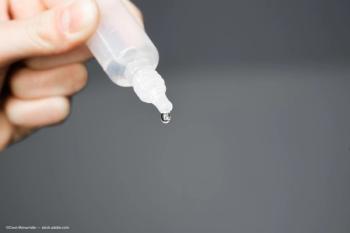
Novel glaucoma treatments factor in scleral behavior
Innovations in sustained-drug delivery and neuroprotection are bringing glaucoma specialists one step closer to additional therapeutic options.
Reviewed by Harry A. Quigley, MD
Glaucoma specialists are on the threshold of monumental changes in therapeutic innovations-from sustained-drug delivery to neuroprotection-that are expected to be available in a relatively short period compared with previous innovations, said Harry A. Quigley, MD.
While lowering of IOP is protective in glaucoma, the current methods by which this is accomplished are wanting because of patient non-adherence to medication regimens.
“We need ways to deliver medications to glaucoma patients that are safe, effective, practical, cost-effective, and have no side effects,” said Dr. Quigley, the A. Edward Maumenee Professor of Ophthalmology and director, Glaucoma Center of Excellence, Wilmer Eye Institute, Johns Hopkins University School of Medicine, Baltimore.
Sustained-drug delivery
Sustained delivery seems to be an answer because it minimizes adherence problems, eliminates infection, lowers the dose/side effects with targeted delivery, and provides a broader range of potentially effective medications, he noted.
Medications can be delivered in a sustained fashion in a number of ways: contact lenses, punctal plugs, a tube with reservoir device, intravitreal capsules, and subconjunctival injections-the last of which Dr. Quigley favors.
“Subconjunctival injection is the most secure method that can lower IOP for 6 months and provide documented protection,” he said.
His laboratory is working on administration of dorzolamide injections to lower IOP, which might be combined with a neuroprotector. His group showed that dorzolamide microparticles were neuroprotective in a rat model of glaucoma. One subconjunctival injection of dorzolamide microparticles resulted in half of the ganglion cell loss in the animal model.
Neuroprotection
A murine model created in that laboratory allows real-time observation of individual axons in the eye and the changes that they undergo with various medications. This model has practical applications when viewing how the lamina cribrosa changes in glaucoma, i.e., excavation produced by deformation.
“The lamina cribrosa of the optic nerve head changes dramatically in glaucoma,” Dr. Quigley said. “The entire structure remodels so that the lamina goes backward and becomes wider and bows outward in its attachment to the sclera.”
In contrast, the rigid Bruch’s membrane does not get wider, and behind it the eyeball enlarges with resultant hoop stress. The hoop stress has the most important effect on the lamina compared with other forces, i.e., the translaminar pressure difference in the eye and the optic nerve tissue pressure, in that the hoop stress pulls the lamina outwardly the full 360° around the lamina.
IOP exerts stress on the eye at normal pressure, but if an eye “gives more” at normal pressure, then the connective tissue and blood flow might be killing the ganglion cells, he noted.
“A potential neuroprotective response might be to change the responses of the sclera and lamina cribrosa to protect retinal axons,” he said.
Dr. Quigley and colleagues at Johns Hopkins University saw that they could stiffen the sclera in murine eyes by crosslinking the scleral tissue with glyceraldehyde. They found that with increased IOP there was greater axon loss.
“We affected glaucoma susceptibility by altering the scleral behavior in mouse eyes,” he said.
The next step was investigation into the proteomics of the sclera of the mouse eye that had been subjected to experimental pressure elevation. Along with Gulgun Tezel, MD, from Louisville, KY, investigators found that inhibiting the activation of transforming growth factor beta (TGF-Ã) in an eye with glaucoma might be beneficial and achieve the opposite effect of that achieved with glyceraldehyde.
Dr. Quigley then experimented with losartan, an angiotensin-converting enzyme inhibitor that inhibits activation of TGF-Ã in patients with Marfan’s syndrome, to determine the effect of the drug in glaucoma.
Mice treated with oral losartan lost 10% of ganglion cells compared with mice treated with only water that lost 30% of ganglion cells. The bottom line was that altering TGF-Ã proved to be beneficial. The benefit of losartan on the axons was very specific, he noted.
“Losartan acts very specifically to protect axons because the drug decreases the axonal transport obstruction at the nerve head, i.e., losartan decreases the scleral bad behavior for the translaminar difference effect on the laminar cribrosa,” Dr. Quigley said.
This drug effect supports the use of injection of subconjunctival microparticles of losartan that provide sustained-drug delivery to interfere with the glaucoma and not affect patients systemically. This is currently being tested in the periorbital tissue in a mouse model.
Other areas of work
Investigators at Johns Hopkins University are also working on a possible neuroprotective drug that inhibits the work of dual leucine zipper kinase (DLK), which provides a major injury signal. An inhibitor of DLK, tozasertib, which binds DLK and promotes retinal ganglion cell survival, was found to be highly protective against glaucoma in rats.
In addition, Dr. Quigley noted that changes in the lamina cribrosa seen on optical coherence tomography might serve as new biomarkers of glaucoma susceptibility.
Harry A. Quigley, MD
This article was adapted from Dr. Quigley’s presentation at Precision Ophthalmology 2016. Dr. Quigley is an advisor for and has received consulting fees from GrayBug Vision Inc. and Sensimed AG and has an ownership interest in GrayBug Vision Inc.
Newsletter
Don’t miss out—get Ophthalmology Times updates on the latest clinical advancements and expert interviews, straight to your inbox.













































